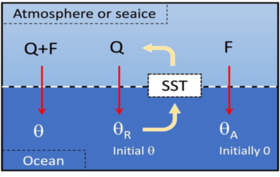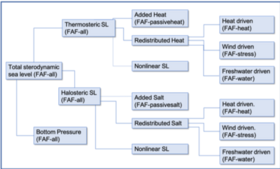DECVAR: Sea Level Changes Mechanisms in the MPI-ESM under FAFMIP forcing conditions
by Xiaolin Zhang, Sayantani Ojha, Armin Köhl, Helmuth Haak, Johann H. Jungclaus, and Detlef Stammer/UNIHH, MPI


The Flux-Anomaly-Forced Model Intercompari-son Project (FAFMIP) Experiment was implemented to rationalize differences occurring between the projections of individual models under the idealized FAFMIP forcing. The imposed anomaly patterns for wind stress, heat, and freshwater fluxes were derived from CMIP5 “1pctCO2” runs at the time when doubled CO2 concentration has been reached. The objective here is to quantify the response of dynamic sea level due to these individual forcing changes.
The study is based on the output of the Max-Planck-Institute Earth System Model (MPI-ESM) coupled AOGCM run in a high-resolution setting using FAFMIP forcing anomalies. The goal is to understand mechanism how individual forcing component dynamically and kinematically affect sea level change. The kinematic effects is quantified by passive tracers that for temperature accumulates and advects the absorbed heat (qA in Fig.1) while the effects from the change in dynamics are quantified by redistribution tracers (for temperature qr in Fig.1).
The total sealevel response can then be decomposed into the components form salinity and temperature changes and a small redistribution of mass (Fig.2). With the help of the responses due to individual forcing components and the contributions from the additional traces, a complete decomposition into the dynamic and kinematic effect of the forcing changes is achieved
We found that thermosteric dominates the total SL and halosteric component mainly contributes north of 60°N. The estimation of the added and redistributed components further suggest that the added component dominates the thermosteric SL and the redistributed component dominates the halosteric SL. The strong impact of heat flux in causing the SL change outside of the Southern Ocean and north of 60ºN is evident whereas the freshwater flux is mostly counter acting poleward of 40˚N/S except some parts of the Arctic Ocean
Reference
Zhang, X., Ojha, S., Köhl, A., Haak, H., Jungclaus, J. H., & Stammer, D. (2022). Sea level changes mechanisms in the MPI-ESM under FAFMIP forcing conditions. Climate Dynamics, 1-23.
